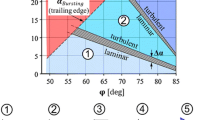Abstract
The passive control of the tip vortex generated by an oscillating NACA 0012 wing via a tip-mounted half-delta wing, in both regular and reverse configurations, was investigated experimentally at Re = 2.45 × 105. Velocity and vorticity measurements, performed using a miniature triple hot-wire probe, show that vortex breakdown occurred when the regular half-delta wing (HDW) was mounted, but not for the reverse half-delta wing (RHDW) configuration. The HDW vortex breakdown led to a rapidly diffused tip vortex, suggesting an enhanced wake-vortex decay. For the RHDW wing configuration, the tip vortex remained concentrated but had a smaller size and also a weaker strength and rotation compared to the oscillating baseline wing. In addition, the vortex center of the oscillating RHDW wing-generated tip vortex was also found to be greatly displaced, especially in the transverse direction, which could translate into an increased blade-vortex-impingement miss distance and, as a result, an alleviated blade-vortex interaction.







Similar content being viewed by others
Abbreviations
- AR:
-
Aspect ratio
- b :
-
Semi-span
- c :
-
Chord
- C L :
-
Total lift coefficient
- C l :
-
Sectional lift coefficient
- f :
-
Frequency
- r c :
-
Vortex core radius
- Re :
-
Chord Reynolds number
- S BW :
-
Baseline wing area
- S HDW :
-
HDW surface area
- S total :
-
Total wing area, =S BW + S HDW
- t :
-
Half-delta wing thickness
- u, v, w :
-
Mean axial, transverse and spanwise velocity
- u c :
-
Axial core velocity
- u ∞ :
-
Free-stream velocity
- x, y, z :
-
Streamwise, transverse and spanwise direction
- α :
-
Angle of attack
- α d :
-
Pitch-down α
- α max :
-
Maximum angle of attack
- α ss :
-
Static-stall angle
- α u :
-
Pitch-up α
- κ :
-
Reduced frequency, =πfc/u ∞
- v θ :
-
Tangential velocity
- v θ,peak :
-
Peak tangential velocity
- ζ :
-
Streamwise vorticity
- ζ peak :
-
Peak streamwise vorticity
- Γ :
-
Vortex circulation
- Γ b :
-
Bound circulation
- Γ c :
-
Core circulation
- ω :
-
Circular frequency, =2πf
References
Birch D, Lee T (2004) The structure and induced drag of a tip vortex. J Aircraft 41(5):1138–1145
Breitsamter C, Allen A (2009) Transport aircraft wake influenced by oscillating winglet flaps. J Aircraft 46(1):175–188
Chang JW, Park SO (2000) Measurement in the tip vortex roll-up region of an oscillating wing. AIAA J 38:1092–1095
Chen SH, Ho CM (1987) Near wake of an unsteady symmetric airfoil. J Fluids Struct 1:151–164
Duraisamy K, Baeder JD (2003) Control of tip vortex structure using steady and oscillatory blowing. AIAA Paper 2003–3407
Ericsson LE, Redding JP (1988) Fluid mechanics of dynamic stall. Part I. Unsteady flow concept. J Fluids Struct 2:1–33
Gieseke TJ, Guezennec YG (1993) An experimental approach to the calibration and use of triple hot-wire probes. Exp Fluids 14:305–315
Greenblatt D (2012) Fluidic control of a wing tip vortex. AIAA J 50(2):375–386
Greenblatt D, Vey S, Paschereit OC, Meyer R (2009) Flap vortex management using active Gurney flaps. AIAA J 47(2):2845–2856
Hardin JC, Lamkin SL (1987) Concepts for reduction of blade/vortex interaction noise. J Aircraft 24(2):120–125
Hasebe H, Naka Y, Fukagata K (2011) An attempt for suppression of wing-tip vortex using plasma actuators. J Fluid Sci Tech 6(6):419–437
Lee T, Basu S (1998) Investigation of unsteady boundary layer developing on an oscillating airfoil. Exp Fluids 25:108–117
Lee T, Pereira J (2010) On the nature of wake- and jet-like axial tip-vortex flow. J Aircraft 47(6):1946–1954
Lee T, Su YY (2012) Wingtip vortex control via the use of a reverse half-delta wing. Exp Fluids 52(6):1593–1609
Lowson MV, Riley AJ (1995) Vortex breakdown control by delta wing geometry. J Aircraft 32(4):832–838
Matalanis CG, Eaton JK (2007a) Wake vortex control using static segmented Gurney flaps. AIAA J 45(2):321–328
Matalanis CG, Eaton JK (2007b) Wake vortex control using rapidly actuated segmented Gurney flaps. AIAA J 45(8):1847–1884
Moffat RJ (1985) Describing the uncertainties in experimental results. Exp Thermal Fluid Sci 1:3–17
Rennie R, Jumper EJ (1996) Experimental measurements of dynamic control surface effectiveness. J Aircraft 33(5):880–887
Rossow V (1999) Lift-generated vortex wake of subsonic transport aircraft. Prog Aero Sci 35:507–660
Spalart PR (1998) Airplane trailing vortices. Ann Rev Fluid Mech 30:107–138
Taira K, Colonius T (2009) Effect of tip vortices in low-Reynolds-number poststall flow control. AIAA J 47(3):749–755
Acknowledgments
The work was supported by the Natural Science and Engineering Research Council (NSERC) of Canada.
Author information
Authors and Affiliations
Corresponding author
Rights and permissions
About this article
Cite this article
Lee, T., Pereira, J. Passive control of unsteady-wing tip vortex via a slender half-delta wing in both reverse and regular configurations. Exp Fluids 54, 1564 (2013). https://doi.org/10.1007/s00348-013-1564-9
Received:
Revised:
Accepted:
Published:
DOI: https://doi.org/10.1007/s00348-013-1564-9




